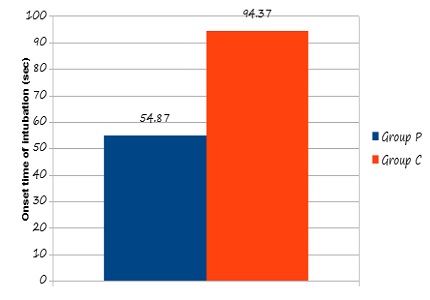A prospective randomized study for comparison of onset time of intubation and intubating conditions using rocuronium with priming and without priming
Abstract
Background: Rocuronium, a non-depolarizing neuromuscular blocking agent, with priming, can be used as an alternative to succinylcholine for rapid sequence intubation because it produces rapid onset of intubation with comparable intubating conditions. We aimed to compare the onset time of intubation and intubating conditions using rocuronium with priming and without priming.
Methods: Sixty adult patients of either sex, aged 18-60 years, ASA grade I and II, scheduled for various elective surgeries under general anaesthesia were randomly allocated into two groups (30 patients in each group). Group P received 0.06 mg/kg of rocuronium as priming dose and Group C received normal saline as placebo before induction. The patients in both groups received fentanyl 1.5 µg/kg and induced with propofol 2.5 mg/kg. The intubating dose of rocuronium 0.54 mg/kg for Group P and 0.6 mg/kg for Group C were given after 3 min of priming. The time interval between the intubating dose and the loss of T1 of TOF stimuli was considered as the onset time of intubation and Cooper’s scoring system was used to compare the intubating conditions.
Results: The onset time of intubation was significantly shorter (P <0.05) in group P (54.87 ± 3.75 sec) than group C (94.37 ± 3.52 sec). Intubating conditions were found to be excellent in both the groups with no any adverse effects.
Conclusion: Rocuronium (0.6 mg/kg) with priming provides rapid onset time of intubation (<60 sec) along with excellent intubating conditions without any adverse effects which may be particularly useful for rapid sequence intubation and where succinylcholine is contraindicated.
Downloads
References
Savarese JJ, Caldwell JE, Lien CA, Miller RD. Pharmacology of muscle relaxants and their antagonists. In: Miller, (Editor), 6th ed. Philadelphia Churchill Livingstone; 2004;1:490.
Magorian T, Flannery KB, Miller RD. Comparison of rocuronium, succinylcholine, and vecuronium for rapid-sequence induction of anesthesia in adult patients. Anesthesiology. 1993 Nov;79(5):913-8.
Lowry DW, Mirakhur RK, McCarthy GJ, Carroll MT, McCourt KC. Neuromuscular effects of rocuronium during sevoflurane, isoflurane, and intravenous anesthesia. Anesth Analg. 1998 Oct;87(4):936-40.
Shashank DS, Singh NR, Singh LK. Effects of pretreatment with different neuromuscular blocking agents on facilitation of intubation with rocuronium: A prospective randomized comparative study. Indian J Anaesth 2014;58(3):303-8. DOI: https://dx.doi.org/10.4103%2F0019-5049.135043.
Mishra LD, Nath SS, Bhattacharya DP. Effect of priming on intubating conditions produced by atracurium. Indian J Anaesth 2003;47(6):458 62.
Kopman AF, Khan NA, Neuman GG. Precurarization and priming: a theoretical analysis of safety and timing. Anesth Analg. 2001 Nov;93(5):1253-6.
Bissinger U, Rex C, Lenz G. [Intubation conditions following administration of atracurium and vecuronium. Bolus method versus priming technique]. Anaesthesist. 1996 Jun;45(6):512-7.
Jones RM. The priming principle: how does it work and should we be using it? Br J Anaesth. 1989 Jul;63(1):1-3.
Rao MH, Venkatraman A, Mallleswari R. Comparison of intubating conditions between rocuronium with priming and without priming: Randomized and double-blind study. Indian J Anaesth 2011;55(5):494-8. DOI: https://dx.doi.org/10.4103%2F0019-5049.89882.
Yavascaoglu B, Cebelli V, Kelebek N, Uckunkaya N, Kutlay O.Comparison of different priming techniques on the onset time and intubating conditions of rocuronium. Eur J Anaesthesiol 2002 Jul;19(7):517 21.
Cooper R, Mirakhur RK, Clarke RS, Boules Z. Comparison of intubating conditions after administration of Org 9246 (rocuronium) and suxamethonium. Br J Anaesth. 1992 Sep;69(3):269-73
Sridhar SK, Lagoo JY, Sathyanarayana PS. A comparative study to evaluate the effects of priming on intubating time and conditions with rocuronium bromide. Karnataka Anaesth J 2015;1(2):55-9. DOI: http://www.karnatakaanaesthj.org/text.asp?2015/1/2/55/163077.
Naguib M. Different priming techniques, including mivacurium, accelerate the onset of rocuronium. Can J Anesth 1994;41(10):902 7. doi: https://doi.org/10.1007/BF03010932.
Griffith KE, Joshi GP, Whitman PF, Garg SA. Priming with rocuronium accelerates the onset of neuromuscular blockade. J Clin Anesth. 1997 May;9(3):204-7.
Crul JF, Vanbelleghem V, Buyse L, Heylen R, van Egmond J. Rocuronium with alfentanil and propofol allows intubation within 45 seconds. Eur J Anaesthesiol Suppl. 1995 Sep;11:111-2.



 OAI - Open Archives Initiative
OAI - Open Archives Initiative


